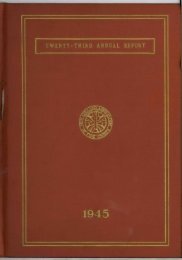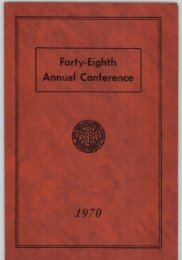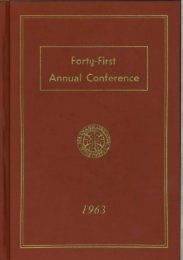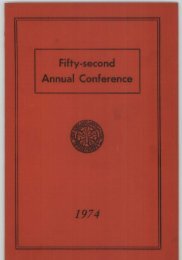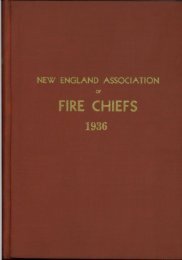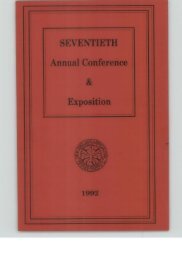NEAFC 31st Annual Conference.pdf - New England Association of ...
NEAFC 31st Annual Conference.pdf - New England Association of ...
NEAFC 31st Annual Conference.pdf - New England Association of ...
Create successful ePaper yourself
Turn your PDF publications into a flip-book with our unique Google optimized e-Paper software.
NEW ENGLAND ASSOCIATION OF FIRE CHIEFS<br />
high, extinguished burners ignited, and general pandemonium ensued. When,<br />
hours later, the city was able to count its toll it totaled three dead, including a<br />
little girl who had been trying to call her father to tell him that the gas was<br />
leaking; injuries to some thirty others; the complete destruction <strong>of</strong> 19 homes; and<br />
serious damage to 25 other buildings.<br />
Yet despite this catastrophe, few gas distributing co.mpanies are even today fully<br />
meeting the resultant recommendations <strong>of</strong> the National, Fire Underwriters or the<br />
United States Bureau <strong>of</strong> Mines.<br />
A further point <strong>of</strong> difference between natural and manufactured gas that has<br />
caused ~ much trouble is the former’s tendency to .so dry out the oakum pack’mg between<br />
pipe sections as to cause continucus leaks in lines not elaborately reconditioned for<br />
its use.<br />
The hazard <strong>of</strong> natural gas arising from its absence <strong>of</strong> a warning odor is intended<br />
to be met-in those states having a gas code through a requirement for artificial odorization.<br />
However, it has been found that, under certain co.nditions, as the gas is forced<br />
under high pressure through sand and clay it is sufficiently purified by the filtering<br />
action <strong>of</strong> the earth as to lose its telltale signal.<br />
This tendency <strong>of</strong> gas to travel for consid’erable distances underground has spelled<br />
disaster in several instances. This fugacious fluid has been known to follow water<br />
pipes and other service lines from even relatively remo.te street leaks into homes, where<br />
in at least two instances <strong>of</strong> recent record, it has resulted in loss <strong>of</strong> life and co.mplete<br />
destruction <strong>of</strong> the buildings, The recommended remedy is to place a dry-well around<br />
entering services so that accompanying gas will be vented in the yard before it can<br />
enter the cellar.<br />
The most dangerous fuel <strong>of</strong> all from this latter standlodnt is the so-called bottled<br />
gas, or propane. Being heavier than air, it tends to cling to the ground and accumulate<br />
in low places until ignited. By this time a substantial quantity is <strong>of</strong>ten present involving<br />
considerable areas and several buildings. In addition to this most undesirable property,<br />
propane is very hard to contain with0.ut strict precautions at all points <strong>of</strong> handling,<br />
storage, and use..Whe <strong>Association</strong> <strong>of</strong> Casualty and Surety Companies, 60 John St.,<br />
<strong>New</strong> York City 7, has issued an excellent series <strong>of</strong> pamphlets on this subject, so that<br />
for me to go into extended detail would be repetitious. I do, however, suggest that you<br />
obtain these booklets.<br />
Being practical men, you would have been entitled to the assumption that, even<br />
if the admittedly responsible gas companies choose to disregard fundamental precautions<br />
in the design and cperation <strong>of</strong> their lines, they would have been restrained by adequate<br />
federal and state regulation.<br />
Unfortunately, you would not have been wholly correct. The Federal Government<br />
makes no attempt to regulate either the construction or operation <strong>of</strong> such lines,<br />
and while Massachusetts adopted a natural gas code in May, 19~2, it is so weak in<br />
several <strong>of</strong> its mcst vital points as to <strong>of</strong>fer questionable protection to the public. I refer<br />
most specifically to the low factors <strong>of</strong> safety allowable under the code for even urban<br />
construction, these having probably been inherited from the 1942 version <strong>of</strong> the ASA<br />
code or its successors; to the fact that pipe line constructio.n is permitted within 40<br />
feet <strong>of</strong> an occupied building, a lethal distance in case <strong>of</strong> either explosion or rupture;<br />
and finally to the fact that the real safety test <strong>of</strong> the ASA code, requiring test at 1~0%<strong>of</strong><br />
operating pressure, has been dropped to retain only the leak finding provisio.n <strong>of</strong><br />
,~0 pounds over operating pressur< As is befitting a growing state, <strong>New</strong> York re-<br />
10!



